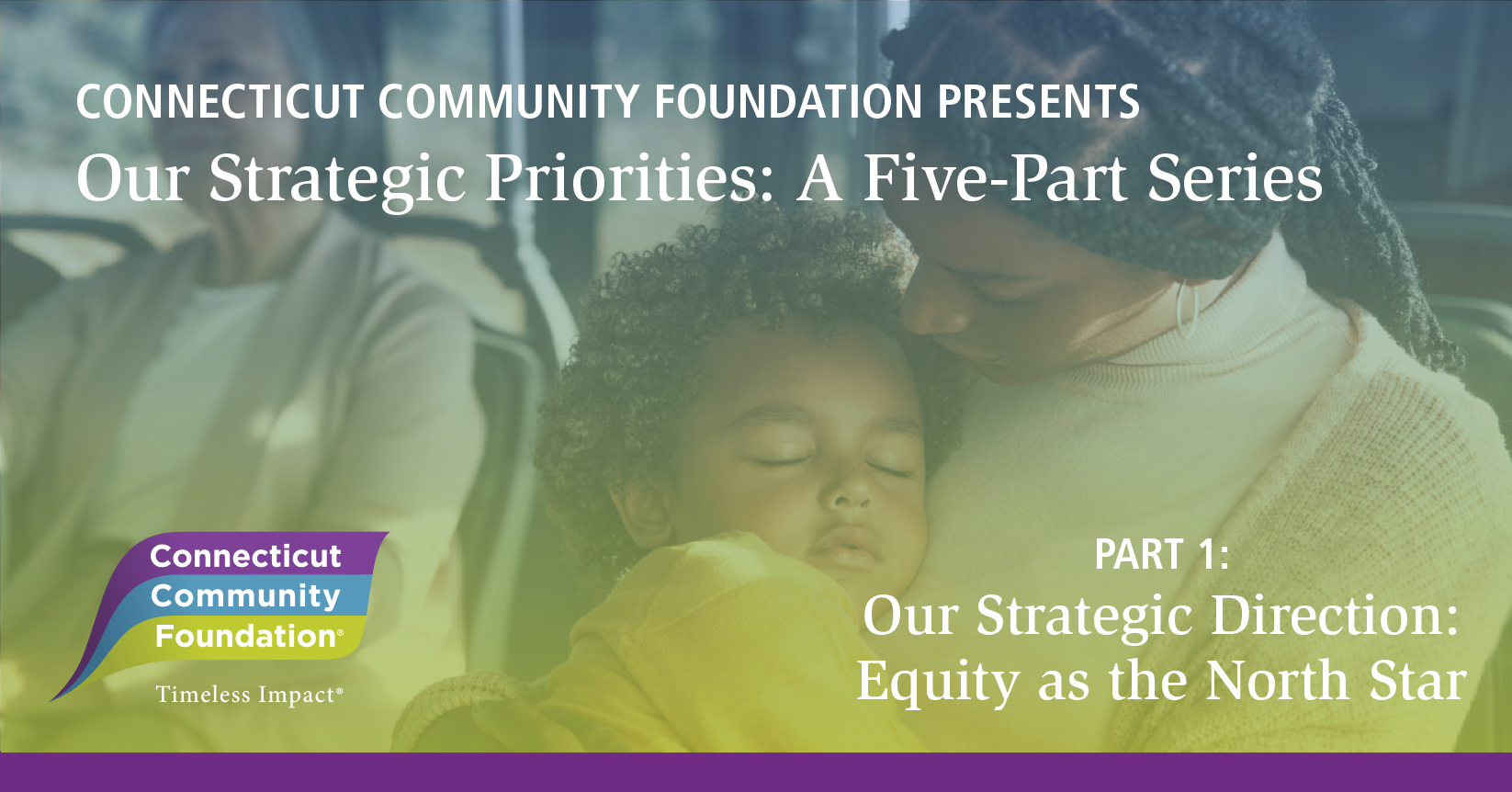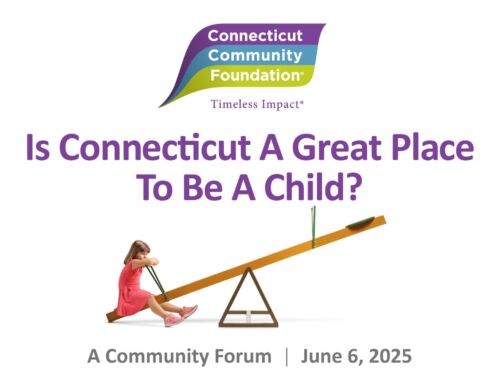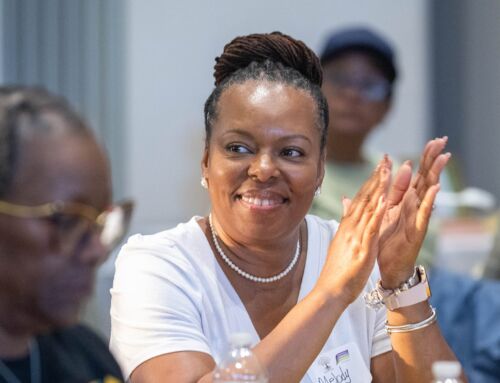
Part 1: Our Strategic Direction: Equity as the North Star
Professor Kathy Taylor, chair of the board of Connecticut Community Foundation, comes at the issue of racial disparities from many angles. As a Black woman living in America, she’s experienced racism first hand. As a professor of Legal Studies at Naugatuck Valley Community College, Diversity, Equity and Inclusion (DEI) consultant, and Founding Chair of the Center for Racial Dialogue and Communal Transformation, Taylor has made taking on racism her life’s work. But it’s her experiences as a mother that shed light on what the concept of equity can mean to a family and, by extension, to an entire community.
Taylor tells the story of when her twins were born prematurely. One was two pounds bigger and came straight home. The other was in the ICU for a week.
“It was only one week but that week made a huge difference. When I found myself nursing them I knew that the smaller baby–we’ll call him Baby B–I knew that Baby B needed more of all of those immunities I could pass on. During the night I would continue to nurse Baby B and my husband would give Baby A a bottle. It wasn’t that Baby A didn’t need the immunities. But Baby B needed them more. For me to treat them equally it would have meant that Baby B didn’t get what he needed.”
As Taylor did with Baby B, Connecticut Community Foundation is focused on deploying the resources we have where the gaps and needs are greatest within the 21-town region we serve in Greater Waterbury and the Litchfield Hills. In 2019, this led us to undertake a strategic planning process grounded in local data – as well as our values – to determine how we can best serve our region and its residents, while evolving to meet changing needs.
“For years, we had spread funding across nine or ten issues, without distinguishing among them” says President and CEO, Julie Loughran. “We were spreading our resources widely, but thinly, and without a clearly articulated direction. We realized we needed to focus. We needed to prioritize. We needed a North Star.”
To find that North Star, the Foundation first needed to get grounded in reality. We had abundant anecdotal evidence of disparities in the service area. But in order to identify where we would be best able to have the greatest impact and make a compelling argument for a change in direction, we began by compiling a data-driven assessment of community needs and gaps, as well our own experience, capacity, and involvement across a range of issues. We also surveyed grantees, community leaders, Foundation volunteers, donors, and other stakeholders. The results were eye-opening.
“We knew disparities existed,” Loughran says. “But the data was stark. In health, education, economic opportunity, financial security – across each area there was a wide gap between those who were thriving and had access to the resources they needed, and those who didn’t. While there were disparities along lines of geography, income, age, gender and other factors, the greatest gaps were along racial lines in every category.”
Rabbi Eric Polokoff, a Foundation trustee and the rabbi at B’nai Israel of Southbury, was shocked at what he learned, particularly regarding disparate outcomes for residents of Waterbury. “One of the things that caught my eye,” says Polokoff, “was that not only is Waterbury behind compared to its surroundings, but in many measures we’re doing worse than other urban areas in Connecticut. We had some of the worst statistics in the state. This is not to blame current leadership. These are long trends. But how do we dig ourselves out?”
The needs assessment, feedback from the community, and an examination of the values of the organization made clear that the Foundation can best support progress in the community we serve through a focus on race and equity. And more specifically on taking a more integrated approach to our work, using all of the tools at our disposal, including grantmaking, advocacy, collaboration, data-sharing, and convening, among others. Central to this work will be an ongoing commitment to solicit and listen closely to a wide range of voices from across the community – including the voices of those from underrepresented or marginalized communities – and to continually evaluate our efforts, adjusting as needed.
Taylor talks about the power of grounding the Foundation’s strategic direction in both data and values. “Maternal health, financial security, educational gaps, rate of eviction, access to transportation. We could see how systems interact to bring about racial disparities. Then it was the realization that if we continue to go along the same path having known what the disparities are, having looked at the stark differences, then now we are a part of perpetuating the cycle. Knowing the information helps make us accountable. The needs assessment led to ownership of the larger problem. Now when you set priorities, when you articulate values, it’s harder to treat everyone the same across the board.”
For Polokoff, the needs assessment resonated with his experiences as a rabbi in suburban Southbury. While it is common to focus on urban areas as locations of greater need, Polokoff notes that the social service network in the suburbs is less developed than in Waterbury, meaning the city is also supporting residents of the suburbs. He notes that when people in the suburbs and rural towns in the Foundation’s region have problems they turn to urban areas for services.” An example is emergency housing,” he says. “If someone is suddenly homeless in the suburbs where do they go? They go to the city. If you think helping an urban environment is a zero-sum game then you’re missing the reality of social services. We’re all linked. There’s an interconnection. Instead of Waterbury and its needs and then everyone else.” As Polokoff explains, explicitly recognizing this connection called on the Foundation to reset how it approaches and talks about the 21-town region it serves across Greater Waterbury and the Litchfield Hills.
“When we looked at the old mission statement it talked about serving communities, plural. But we are one community, not several. We need to view ourselves as one community because we are. It’s not the wealthy suburbs and Waterbury. We serve one community in its entirety.”
Connecticut Community Foundation’s efforts to look inward, listen to voices from across the community, and examine how we can most effectively deploy the resources and tools at our disposal has yielded a new strategic direction, grounded in our values and reflected in a new statement of our mission: To foster an equitable and inclusive community in Greater Waterbury and the Litchfield Hills by inspiring generosity, supporting organizations, and cultivating effective leaders. The mission, in turn, reflects our longer-term vision, of “an equitable, inclusive, just, and vibrant community in which all residents have what they need to thrive.”
This new direction has informed – and will continue to shape – every aspect of our work, from our grantmaking priorities, to our response to the COVID-19 pandemic, to the many ways and places we can stand with and stand up for our community.
As Polokoff reflects, conducting and assessing the Foundation’s work through the lens of equity represents a breakthrough not only in how we conceive of our greatest problems, but also in how best to solve them. “I’m going to suggest to you that what you might see as idealism is also supported by what we might call pragmatism,” Polokoff says. “Equity assists in creating a dynamic in which multiple voices are there working cooperatively in dialogue. To create a dynamic which better fosters success.”
Professor Taylor agrees, while also noting that a shift to equity is not without its cultural challenges.
“We’re so used to using equality as the measure,” she says. “As if everyone is starting from the same point. But if you see someone who’s far behind then you need to bring them up to speed. We can’t think of equity as zero-sum game. It’s not a competition. Thinking back to my twins, I wasn’t taking from Baby A. No, I’m saying that Baby A was already there. We needed to bring Baby B along.”







